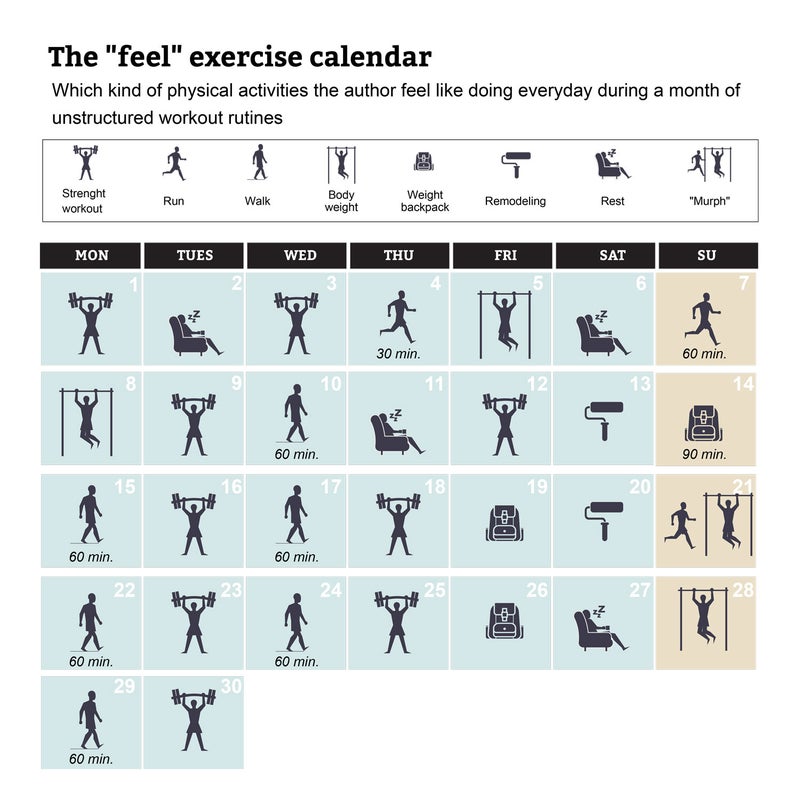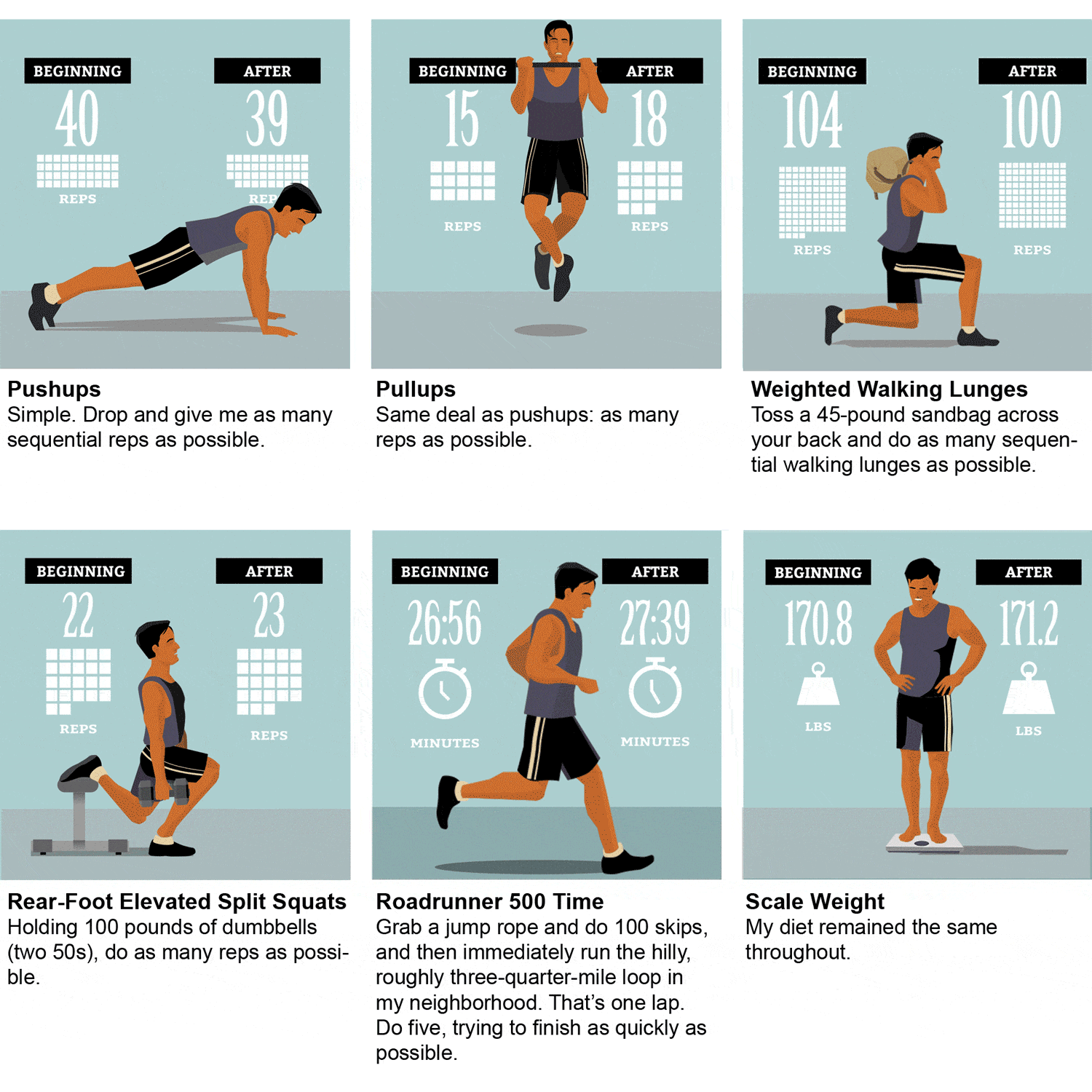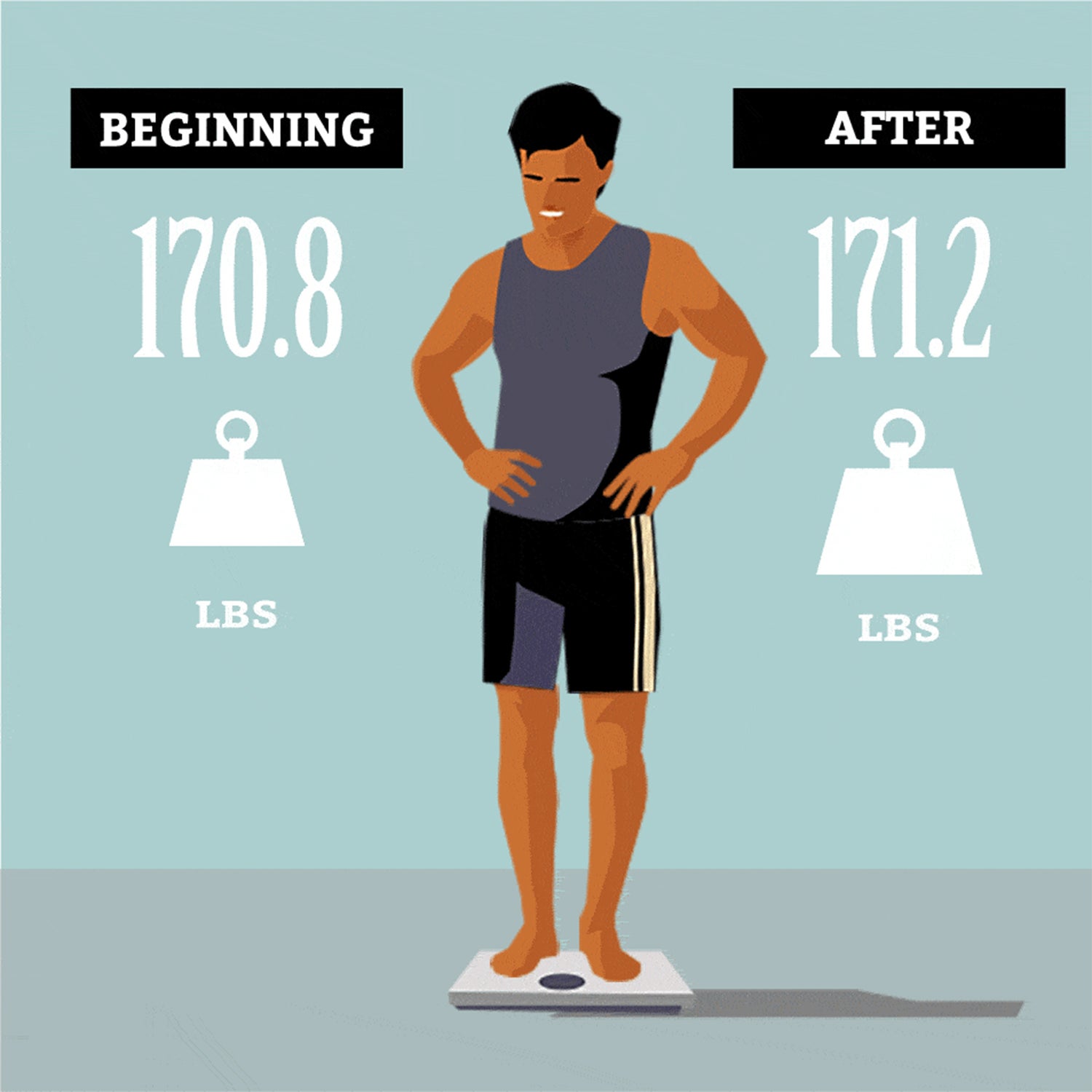It’s 4 p.m. on a Thursday, and I’m in for another beating. I enter the Roadrunner Athletic Club—the unpretentious, one-member, Las Vegas–based gym inside my garage. I eye the lineup of dumbbells, kettlebells, and sandbags parked in front of my pickup, then drop to the yoga mat on the cement floor and begin to stretch for a workout. But something feels off.
As I sink into a hip stretch, my muscles are about as pliable as particle board. And when I stand to grab a 50-pound kettlebell, my strength wanes. The thought of repeatedly snatching the kettlebell from floor to overhead seems about as fun as dropping the weight on my face. I’d normally stuff these feelings and begin cranking my heart into overdrive. But today’s different. I take a deep breath, set down the weight, and change course—I go back inside, plop down on the couch, and start watching a late-’90s episode of Cops.
It’s another day of my monthlong exercise program, an experiment where I’m doing away with any semblance of fitness planning and instead training entirely based on how I feel in the moment. And today? Today feels like a day where I’ll benefit more from Netflix and chilling than I will from working up a sweat.
For half my life, I’ve exercised four or five days every week for one hour—usually two or three precise lifting sessions and one or two prescripted aerobic workouts. I haven’t been “off” an expert-designed fitness program for more than a couple weeks since the airing of the fourth season of The Sopranos. My interest in fitness started as a hobby in high school, grew in college, and eventually became part of my career, a decade of which has been spent writing about health, performance training, and nutrition.
So when my editor at �����ԹϺ��� asked me to see what would happen if I suppressed my affinity for exercise micromanagement and instead moved exactly how and when I felt like it, my reaction was mixed. I looked into the future and saw some possible good—maybe I’d uncover something about myself—but far more bad. What if I lose a step, get hurt, or just come to the realization that I’m an inflexible fitness robot? Nevertheless, I accepted.
My editor’s instructions were simple: Take some basic fitness tests, exercise entirely by disposition for a month, take the tests again, then send me a story.
I tested my pushups, pullups, rear-foot elevated split squats, weighted walking lunges, and aerobic fitness. I also weighed myself on a scale.
Day one: I enter my garage. Absent from the work bench is the usual Excel spreadsheet that charts my month of training and lists the day’s workout.
I begin with some basic stretching, followed by a warmup of dumbbell . My hips feel a bit tight, and the exercise acts like a crowbar to pry them open, but I feel like going hard. I grab heavy dumbbells and do , an exercise that causes my upper legs to feel like blimps, so I know something’s working. Then I do because they’re easier on my shoulders and I can do more reps (which, admittedly, boosts my ego). Then I do weighted pullups because they’re more difficult and the weight vest makes me feel like I’m a kid playing army. Then I grab the dumbbells and do because I want sore hamstrings the next day. Finally, I do biceps curls, a bro-tastic exercise that I haven’t done since college, because, hey, why not? After doing four sets to failure of each of those exercises, I skip my regular core routine because I hate doing core work.
The next day, I don’t exercise because my legs felt like they’ve received a few hundred bee stings. Some trainers say soreness is not a sign of a good workout, and they’re probably right, but this is a freeing, change-signaling soreness. I’m back in the gym improvising on day three.

This pattern continues for a month.
Many of my strength sessions hit the six fundamental movement patterns—push, pull, hinge, squat, plank, and carry—which my friend and renowned fitness expert Dan John make a good combo for most workouts. Some days I’d go hard and heavy, others were less aggressive. At times, a standard weight workout felt plain boring, and I’d do something a little more interesting, like . Occasionally, I’d keep it simple with something like 500 kettlebell swings and some pushups and pullups; other days, I’d give myself a basic goal of running, walking, or walking with weight from home to a location anywhere from one to five miles away and then back home.
At the end of the month, I retake the performance tests and measure my weight.

Not impressed with the data? Well, neither was I. That’s because the numbers do lie. They hide some critical truths—truths that will likely change how I approach exercise from here on out. Here’s what my month of exercising by feel taught me.
Take the Long View
One day, I stood over a 75-pound kettlebell and planned to set a timer for five minutes and do as many reps as possible of the a rather technical exercise at a heavy weight for me. I wanted to do it, and my anarchic program said I should. But impulses also tell me to buy a motorcycle, eat Lucky Charms for every meal, and head down to the casinos near my home and play blackjack. In exercise, as in life, just because you want to do something doesn’t mean you should.
My goals have usually been performance oriented; for example, rowing 2,000 meters in less than seven minutes, running a sub-1:30 half marathon, deadlifting twice my bodyweight, doing 15 or more pullups. But once I hit those goals, I, like most people, extended them. Faster, heavier, more reps. I did 100 snatches in less than five minutes with a 55-pound kettlebell. Why not try with the 75-pounder?
Here’s why: The long view of why I train is that I want to feel good, be physically capable of doing the things I love, and infrequently visit the hospital from now until I die at, fingers crossed, a very old age. Ripping a big-ass weight from the ground a bunch of times may improve my capacity, but is it making me feel good and stay “healthy”? That’s debatable.
Performance and health are not the same. “Performance is about pushing boundaries. Health is about staying within them,” says Trevor Kashey, an Ohio-based performance and nutrition coach. Like a Venn diagram, the benefits most people see from training for performance and/or health overlap. But the more you push performance, the further you get from health. “Where that exercising-yourself-into-pain-and-suffering threshold lies is totally individual and also determined by your training method of choice, because some training methods are inherently riskier,” Kashey says.
Consider that found you need only burn roughly 1,000 calories or run seven miles each week to significantly reduce your mortality risk. A large body of evidence suggests having a larger amount of muscle improves health and disease outcomes. “But adequate isn’t really about building muscle,” Kashey says. “It’s about loss prevention.” That’s something you can do by eating enough protein and hitting minimal activity requirements.
Standing over the kettlebell, I realized that I fall somewhere in between exercising for maximum performance and exercising for health. While I know intellectually that pushing myself to hit faster splits or pump heavier weights just to say I can won’t necessarily leave me any healthier, I’m still inclined to do so. But without a specific performance goal, just being active regularly is enough to help me achieve longevity and positive health—which should arguably be the goal in and of itself. The trick for me, I realized, is finding a happy medium—choosing performance goals that don’t potentially leave me burned out or injured (my current track before this experiment), but also keep me motivated and excited about following some sort of training plan (which requires a little more direction than my approach over the past month).
Walking Is Ridiculously Underrated
Before this grand experiment, I was nearly always good for a couple weekly runs. But one day during this month, I laced up my running shoes and faced an alarming pre-run mental dialogue: I’d rather do my taxes inside a bullfighting arena than jog right now.
I’d normally just shut up and pound pavement. Sure, I haven’t ever regretted a run, but most of my runs have moments of sheer shittiness. So why bother? This experiment dictates that I ����dzܱ����’t run if I don’t want to. (So I didn’t.) But I still wanted to do something active.
I leashed my dogs, and we walked my regular running route in the desert foothills behind our home. There was no pacing, no coordinated breathing, no considered foot-strike patterns. This was an unplugged, untimed, unmanaged experience, complete with stops to sniff around and soak in the surroundings.
Did my fitness suffer for it? Probably not all that much. Consider a that found no differences in body composition changes between people who did shorter, higher-intensity exercise bouts compared to people who did longer, lower-intensity exercise. Caloric burn is caloric burn, regardless of the burn rate. Other suggest walkers live just as long as more-intense exercisers. Of course, my walk took twice as long to see equal benefits, but it was worth the time—and it made me feel fresher the next day.
Consider my friend , a 6'2″, 250-pound former UFC fighter who trains twice a day and is the fittest person I know. A few years back, he saw a drastic jump in his strength and endurance—something that just doesn’t happen to people at his level of performance. Perplexed, Maximus analyzed what had changed and could only find one answer: He’d recently adopted a dog and was walking 30 to 60 minutes a day, which, he thinks, was helping him recover much faster.
Walks replaced my runs for the rest of the experiment. Most times I’d leave my phone at home so I could completely unplug and be present in nature, which gave me a physical and mental benefit. Research from the University of Utah shows that people who walk in nature without their phone scored better on memory tests and showed changes in their brain that suggest significant mental restoration compared to people who walked with their phone.
Yeah, I’ll surely still run relatively frequently—different heart rates do seem to deliver unique cardiovascular benefits—but I’ll also do a lot more walking.
Consult an Expert
I know more about health and fitness than the average person, but as a journalist, it’s my duty to not pose as an expert. Yet even certifiable experts—the ones with advanced degrees who conduct or follow research and work with clients 40 hours a week—may not want to create their own programs, says , owner of Core, a Boston-based gym.
“I know the body and how to write solid training programs,” Gentilcore says. “But the last person I want to write a program for is myself. Just like everyone else, I’m prone to my own biases and tend to gravitate toward what I’m good at or what’s ‘easy.’”
Take me, for example: By week two, my lower back ached—because I’d been neglecting the core work I loathe. By avoiding what you don’t want to do, you overlook what you’re bad at or just don’t like (like, ahem, running). And it’s often the latter that keeps your healthy and fills your fitness gaps. An expert-designed program holds you accountable and covers your blind spots.
The DIY method is probably not ideal for most people, because the vast majority don’t have a firm grasp on fitness program design, says Kevin Carr, co-founder of . “There should be a balance between mobility, strength, power, and aerobic activity in your program. That’s true in individual training sessions as well as in how the workouts come together over weeks and months.” When you don’t understand that, you end up having blind spots that hurt your fitness or set you up for injury.
Not all people can or will hire a coach, and that’s fine. Buy a program online, Carr says, and learn what constitutes a solid gym workout for most fitness goals. Do five to ten minutes of mobility work, followed by strength and power work where you push (like a pushup), pull (pullup), hinge (hip bridge), squat (squat), and plank. Finish with something that gets your heart rate up. That covers the five fundamental human-movement patterns and checks an aerobic box.
You Can Build Fitness Anywhere
There was one day during this period when I wanted to work out but had in-laws heading into town and a long list of chores. As someone who has always believed that exercise can only really happen in the gym or with a prescribed running workout, my lack of time should have posed a problem. Feeling innovative, I placed a 45-pound sandbag inside my backpack. Then I tossed the backpack over my shoulders and started crushing tasks: folding laundry, cleaning the kitchen, vacuuming, mopping—each chore morphing into exercise thanks to the added weight.
I moved for two hours while wearing that pack. The military calls this rucking, and it’s an . It burns roughly three times the calories of walking, helps relieve and prevent back pain, makes you stronger everywhere, builds your endurance without impact, and rounds out your fitness.
That pack is forever my new chore buddy. Turns out you don’t always have to choose between exercise and getting shit done.


